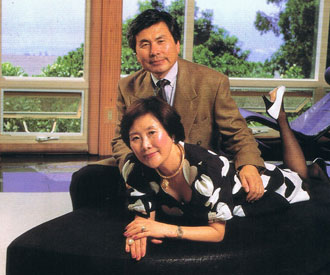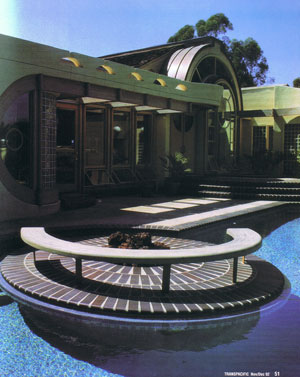|
GOLDSEA |
ASIAMS.NET |
ASIAN AMERICAN PERSONALITIES
THE 130 MOST INSPIRING ASIAN AMERICANS
OF ALL TIME
C. W. Kim
PAGE 1 OF 2
 he long-awaited Pacific Trade Center in L.A. Koreatown never did get off the ground in the wake of the Koreatown Riots, but architect C. W. Kim has built enough high-profile buildings to take credit for the best part of the San Diego skyline. Among the most distinctive are the elegantly sail-shaped Spinnaker (completed 2007) and the hexagonal towers of the Emerald-Shapery Center that look something like giant alien crystals jutting into the sky.
he long-awaited Pacific Trade Center in L.A. Koreatown never did get off the ground in the wake of the Koreatown Riots, but architect C. W. Kim has built enough high-profile buildings to take credit for the best part of the San Diego skyline. Among the most distinctive are the elegantly sail-shaped Spinnaker (completed 2007) and the hexagonal towers of the Emerald-Shapery Center that look something like giant alien crystals jutting into the sky.
C. W. Kim's reputation as San Diego's most celebrated architect is a tribute to years of hard work and fueled by his love of the profession. "I am so happy to solve a problem, and there is no problem that I cannot solve," he says in typical unabashed style. "Doing a good job is good marketing. I let my projects do the selling for me."
Over the years Kim has been responsible for more major San Diego landmarks than any other single architect, including the 443-room Loews Coronado Bay Resort, the Hotel Intercontinental (now Marriott Hotel), Jack Murphy Stadium expansion, Scripps Clinic and La Jolla Research Laboratory and the 325-acre master plan for Pacific Corporate Center.
Since Kim probably spends more time at the office than at home, it's appropriate he works in one of his designs, the $140 million Emerald Shapery Center. His firm handles a wide range of projects from urban design to architectural highrises. He doesn't believe in specializing because it unnecessarily narrows his range.
Just the same, he has been known to walk away from a project. "If they are jerks and have no respect for me, I don't want to do business with them. I don't want to complain and make a lot of noise."
Kim has a smooth relationship with most of his clients, however, and they keep coming back with more projects. One of his strengths is that he completes most projects on time. If they're late, it's only because there's a delay in getting necessary information from the client. "I never give up on details, even if it means eating into the budget." He manages to do this with a relatively small core staff of 17 architects. On large projects he farms out work to contractors to avoid painful layoffs between projects.
On top of his 12-hour day, Kim is also an assistant professor at the New School of Architecture in San Diego. He serves on the boards of directors for United Way and the La Jolla Museum of Contemporary Art. He speaks at seminars and attends charity events. There isn't much time, it seems, to enjoy the beautiful 5,000-square-foot home he completed in 1991 atop the prestigious La Jolla Country Club Heights. By then he had already spent over a quarter century creating other people's dreams.
C. W. Kim was born on August 6, 1938 in Namwon in Korea's North Cholla Province, the city famous for a tale of love and fidelity called Choon Hyang. Chong Won was the youngest of three sons, eight years behind the oldest. The family owned farm lands but living was difficult. Japan had annexed Korea and its resources were conscripted to Japan's World War II efforts. Kim remembers having walked over two hours each way to elementary school daily.
In 1950 when Kim was in the sixth grade the Korean War broke out, forcing the family to separate to survive. He stayed with his mother in Namwon while his father and older brothers went to Chunjoo, hiding from the communists. His childhood still makes him tearful. "We suffered so much," he says. "That's why I get so emotional and don't want to talk about it. I don't even like to visit there because of all the [bad] memories."
Every time we approached the subject of his childhood or his mother his eyes become misty and distant. "In the winter time, my mother used to..." Choked with emotion he stops for several minutes and doesn't continue the thought. He manages laughingly to recall sewing his own clothes.
After the war when his family reunited at Chunjoo, his oldest brother and mentor Chong Oh suggested Chong Won pursue architecture because he excelled in art and math. From age 14 Kim began reading all he could about architecture.
Chong Oh went to the University of Chicago for his master's and PhD in physics and arranged for Chong Won to come to the States as an unclassified undergraduate in architecture. In 1965 when Kim was 26, he graduated from the University of Washington and began working in Seattle as a draftsman for $2.50 an hour.
Meanwhile, future wife Dong Jin Kim (of a different Kim clan) came to the U.S. in 1963 to study dietics in graduate school at West Virginia University where her favorite cousin was studying medicine. Jean was born in 1942 as the oldest of four daughters to a well-educated, prominent family. Her father was a law professor, fluent in English, German, French and Japanese. Before coming to Virginia Jean had graduated from Ehwa University, Korea's most prestigious and glamorous women's college.
To Jean's dismay the University undergraduate biochemistry classes to earn her master's. Not wanting to compromise her dignity by attending undergraduate courses, she switched to interior design and avoided biochemistry altogether. After her last final in May, 1966, with only a thesis to write, she visited her cousin who had moved to the University of Washington for an internship.
In Seattle Jean was one of only two eligible women for a super-abundance of eligible Korean men. She met C. W. at a Korean community picnic when all the prospective suitors had lined up to greet her. Her cousin investigated Kim's background. Deciding an architect's future may be brighter than a PhD's, he gave his approval. They were married a month later on June 30, 1966 when he was 27 and she was 24. This was a surprise for Kim who hadn't expected to marry until he was 30.
PAGE 2
1 |
2
Back To Main Page
|
|
|
|


This photo of architect C. W. Kim and wife Jean appeared in the Nov/Dec 1992 issue of Transpacific magazine.
|
|
“He found San Francisco too competitive and architecturally unstimulating. He didn't want to return to Seattle, and Los Angeles was too smoggy.”
|

This image of the exterior of the home of C. W. and Jean Kim appeared in the Nov/Dec 1992 issue of Transpacific magazine.
|
CONTACT US
|
ADVERTISING INFO
© 1996-2013 Asian Media Group Inc
No part of the contents of this site may be reproduced without prior written permission.
|
